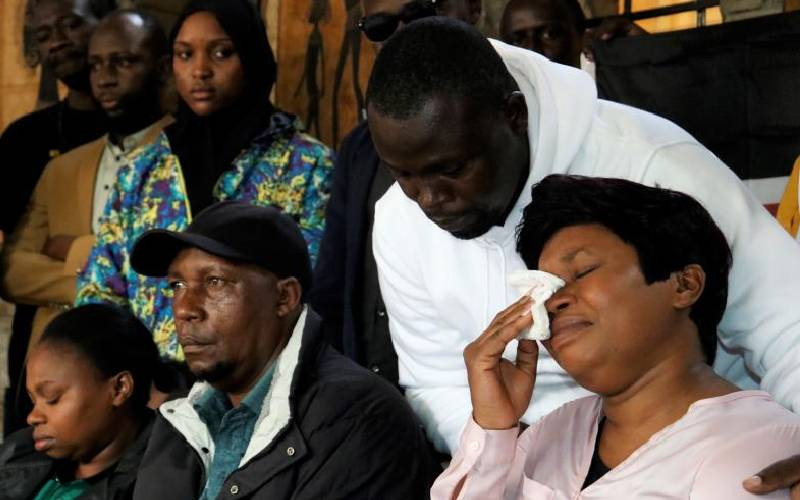|
|
 |
|
|
Residents of KambiTurkana village PHOTO: COURTESY |
By NGARI GICHUKI
Turkana, Kenya: Hundreds of graves welcome you to Kambi Turkana village, Manyatta in Isiolo County, giving the impression of a ghost community.
This village was nearly wiped out by HIV/ Aids in the 1980s. It was so bad that residents now refer to that period as ‘the dark days’.
“Those lying here are the original residents of Kambi Turkana. They died and left behind a ghost town. Being their relatives, we had to come and continue with their legacy since the handful left behind deserted the place,” says Joseph Emorio, one of the elders in Manyatta.
Emorio says ignorance, cultural practices and illicit brews fanned the spread of the virus in the village.
“Even the health clinics around had not acquired the equipment necessary for making correct diagnosis. People would only be treated for the opportunistic infections that were easily diagnosed and then revert back to their reckless ways of drinking illicit brews and engaging in sex with multiple partners without protection,” he says.
Sexual advances
The setting up of an army training camp near the village worsened matters. Emorio tells of how both girls and widowed women used to accept soldiers’ sexual advances in exchange for bread, sugar and other favours all the while spreading the deadly virus.
“The situation got so bad that more than five deaths would be reported daily. Witchcraft was blamed but no amount of cleansing would rid the community of the ‘curse’. This led to a full blown epidemic,” said Emorio.
Almost 30 years later, the impact of the epidemic is still being felt, few children can be found playing nearby with their mothers keeping vigil perhaps guarding the community’s only hope of continuity. But still the feeling of being in a ghost town can be felt throughout the village.
According to the county’s HIV and STI (sexually transmitted infections) co-ordinator Halima Abgudo, the situation is still far from being salvaged. There are mushrooming illicit brew drinking dens in the area greatly threatening the control of the disease despite the rampant national and county campaigns.
Alcohol consumption impairs one’s judgment leading to risky behaviour that promotes the spread of HIV.
Illicit brew menace
“A holistic approach is needed in dealing with this issue of illicit brew in the county. This is because everyone should be sensitised on its contribution to the spread of HIV. Those mostly affected by the illicit brew menace are between the ages of 15 and 25. The same age group that is highly sexually active. This situation needs urgent attention if we are to prevent a catastrophe,” says Abgudo.
As one of the many measures to curb illicit brews, the county government in partnership with Action Aid has launched an initiative dubbed ‘Food for work’ programme.
Stay informed. Subscribe to our newsletter
The programme brings together youths to work on community projects such as digging boreholes, building gabions and cultivation. In return they get food as payment, this aims at eliminating idleness, which has been blamed for driving the community into illicit brews and other drugs.
This approach has radically changed the outlook of Isiolo residents. It has saved more youths from indulging in risky vices. However, this does not mean the illicit brew menace has been eradicated.
Reports by the Ministry of Health indicate that a considerable global burden of disease is attributable to alcohol abuse. A study by Nacada in August 2010 on the correlation between alcohol abuse and HIV infection showed that, alcohol abuse is a major driver of the HIV/Aids pandemic. Alcohol abuse is associated with multiple sex partners and unprotected sexual intercourse.
Alcohol dependence and HIV infection have a “symbiotic” relationship. Alcohol dependence is both a risk enhancing behaviour and a coping strategy for persons living with HIV. There is likelihood of persons abusing alcohol defaulting on their antiretroviral therapy treatment once under the influence of alcohol.
 The Standard Group Plc is a
multi-media organization with investments in media platforms spanning newspaper
print operations, television, radio broadcasting, digital and online services. The
Standard Group is recognized as a leading multi-media house in Kenya with a key
influence in matters of national and international interest.
The Standard Group Plc is a
multi-media organization with investments in media platforms spanning newspaper
print operations, television, radio broadcasting, digital and online services. The
Standard Group is recognized as a leading multi-media house in Kenya with a key
influence in matters of national and international interest.
 The Standard Group Plc is a
multi-media organization with investments in media platforms spanning newspaper
print operations, television, radio broadcasting, digital and online services. The
Standard Group is recognized as a leading multi-media house in Kenya with a key
influence in matters of national and international interest.
The Standard Group Plc is a
multi-media organization with investments in media platforms spanning newspaper
print operations, television, radio broadcasting, digital and online services. The
Standard Group is recognized as a leading multi-media house in Kenya with a key
influence in matters of national and international interest.









